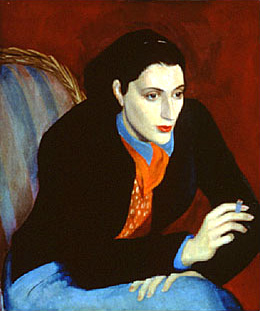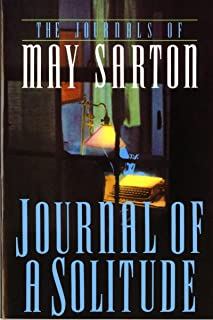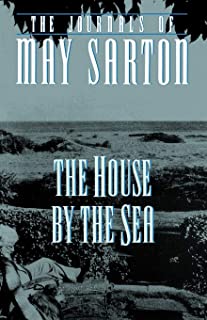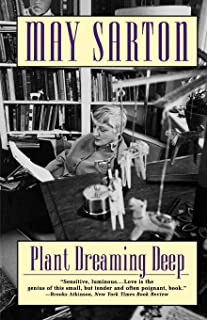- Read
- On The Writer
- On The Writing
- Favorite Quotes
- Photos
- Film and Audio
- Bibliography
- News
- Order Books
May Sarton, classic poet by Will Elliott
"I loved them (the muses) in the way that one loves at any age, if it's real at all. Obsessively, painfully, with wild exaltation, with guilt, with conflict. I wrote poems to and about them. I put them into novels, disguised, of course. I brooded upon why they were as they were, so often maddening. I wrote them ridiculous letters. I lived with their faces. I knew their every gesture by heart. I stalked them like wild animals. I studied them as if they were maps of the world and, in a way, I suppose they were. Love opens the doors into everything as far as I can see, including, and perhaps, most of all, the door into one's own, secret, and often terrible and frightening, real self."- May Sarton, from Mrs. Stevens Hears the Mermaids Singing.
Essayist, novelist, journal writer, feminist, lesbian, and poet, May Sarton, was born in Wondelgem, Belgium, on May 3, 1912. She was the only child of George and Mabel Sarton. In 1916, as the German war machine approached Belgium, the Sartons immigrated to the United States, settling in Cambridge, Massachusetts. There, Sarton's father, an esteemed historian of science, joined the faculty of Harvard University.
With the assistance of several grants from the Carnegie Institute, George Sarton devoted most of his free time to his scholarship. Likewise, Sarton's mother, an artist and designer, was perpetually immersed in her work. Looking back on her childhood, Sarton often said she felt neglected as a child.
May Sarton was the product of two distinct cultures: Belgium and her adopted country, the United States. When she was 12, Sarton spent a year at the Institut Belge de Culture Française. There, she met her first muse: Marie Closset, who published poetry under the pseudonym, Jean Dominique. It was Closset, Sarton said, who first sparked her passion for creating poetry.
Upon graduating from Cambridge's High and Latin School, in 1929, Sarton was offered a full scholarship to Vassar College. She declined the offer, much to her father's dismay. Instead, she moved to New York City, where she pursued a career as an actress. She became an apprentice in Eva Le Gallienne's Civic Repertory Theatre and, eventually, appeared in several of the company's productions.
But Sarton never stopped writing poetry. After the Great Depression claimed Le Gallienne's theatre company, Sarton founded her own Associated Actors Theatre Company. When that, too, failed, Sarton had reached a crossroads in her young life; she decided to forsake acting and resolved to dedicate herself to her writing.
Supported by her father throughout her young adulthood, Sarton rarely held a job. She frequently returned to Europe where she fell into the company of Virginia Woolf, Elizabeth Bowen, Julian and Juliette Huxley, Luge Poe, Basil de Selincourt, Hilda Dolittle, Stephan Spender, W.H. Auden, Dame Edith Sitwell and SS Kotelinsky.
In 1937, her first collection of poetry, Encounters In April, was published. A year later, her first novel, The Single Hound, appeared on bookstore shelves. Though she had very few (if any) credentials, Sarton, in the 1940s, began lecturing (and, eventually, teaching) on the art of poetry at colleges and universities throughout the United States.
Other works by Sarton soon followed, including her second volume of poetry, Inner Landscape, in 1939, her novel, The Bridge of Years, in 1946, the novels Shadow of a Man, in 1950, and Shower of Summer Days, in 1952. The following year, Sarton's third collection of poetry, The Land of Silence, won the Reynolds Lyric Award. In 1954, Sarton wrote her first memoir, I Knew a Phoenix. In 1958, her volume of poetry, In Time Like Air, which many critics believe to be one her best works in the genre, was nominated for a National Book Award.
Sarton did not achieve any measure of financial independence until after her parents had died. In 1958, she sold her childhood home in Cambridge, where she had lived, off and on, until she was well into her forties. Dismayed by what she believed to be her lack of serious critical attention as a poet and writer, Sarton decided to withdraw from the world, at least to a degree. She bought an old house in the remote hamlet of Nelson, New Hampshire. It was there where she created many of her most distinguished and popular works.
In 1961, she wrote the novel, The Small Room, followed, in 1965, by the autobiographical novel, Mrs. Stevens Hears the Mermaids Singing. It was in Mrs. Stevens that Sarton "came out" as a lesbian. In 1968, she published her second memoir, Plant Dreaming Deep. In 1969, she published the novella, The Poet and the Donkey, followed, in 1970, by the popular novel, Kinds of Love.
In 1973, Sarton published what is arguably the most distinguished work in her canon, Journal of a Solitude. Praised by critics and feminists alike, Journal of a Solitude depicted the writer as a strong independent artist who was at the peak of her form. Journal of a Solitude continues to be required reading in many women's studies courses at colleges and universities throughout the country. The book's enduring popularity also significantly expanded Sarton's reading audience.
Commenting on Sarton's work in her book, Hamlet's Mother and Other Women, Carolyn Heilbrun writes, "I would name 1972 as the turning point for modern women's autobiography...the publication of Journal of a Solitude in 1973 may be acknowledged as the watershed in women's autobiography."
Throughout this period, Sarton also published several volumes of poetry, including, Cloud, Stone, Sun, Vine, in 1961, A Private Mythology, in 1966, As Does New Hampshire, in 1967, A Grain of Mustard Seed, in 1970, and A Durable Fire, in 1972.
Shortly after Journal of a Solitude was published, Sarton sold her house in New Hampshire and moved to a rented house by the ocean, in York, Maine. There, she continued to produce works, including a series of journals, The House by the Sea in 1977, At Seventy in 1982, Endgame in 1992, Encore, in 1993, and At Eighty-Two, in 1995, and novels, such as Anger, in 1982, The Magnificent Spinster, in 1985, and The Education of Harriet Hatfield, in 1989. She also continued to publish volumes of poetry, such as Halfway To Silence, in 1980, Letters From Maine, in 1984, and The Silence Now, in 1988.
In World of Light, a 1979 documentary on Sarton, produced by Martha Wheelock and Marita Simpson for Ishtar Films, Sarton, speaking on the art of writing poetry and her own creative process says, "...I don't write poems very often and when I do, they come in batches and they always seem to be connected to a woman, in my case, a muse who focuses the world for me and sometimes it's a love affair and sometimes it's not. This is why I write poems; to find out what I'm really feeling. I can never write in form unless I'm inspired."
"And when I write in form it's anything but something intellectually worked-for. The lines run through my head and I can't stop them. I wrote the whole sequence - the Divorce of Lovers sequence - on a lecture trip when I had a high fever and I was terribly exhausted, and the poems would just push me. I'd have to get up in the middle of the night and write them all down. They just flowed through me, and this is a good example of real inspiration; it was out of a lot of pain and suddenly the whole thing just came through in the poem."
"...It isn't easy to be a woman poet. Partly, because it has always seemed - and this may be true of the woman writer, the woman artist, in general - that one is a little outside the mainstream; not at the center of life. We now can begin to hope that we, as women writers, can be whole human beings who no longer have to be recluses, like Emily Dickinson, or women with forty lovers, like George Sands."
"We have to make myths out of our lives in order to sustain them and I think this is partly how one handles the monster, really...Life must flow through you at every moment and through every day. You're really a receptacle, an instrument for life to flow through and if you keep stomping it with over-control, it's not good, whether you're a creator, or not. So, there, too, I think I've taken a stand on letting one's feelings out; on honoring one's feelings, even when they may seem negative. If you examine anger, it has a great deal to teach you and it has growth in it - the possibility of growth -, if you can face it."
"I think the deeper you go into the personal, the more universal you are. I mean, if you can go deep enough and if it's no longer a sort of 'look at me, I'm in pain' poem. And, of course, the image is what does it; the image is key. When you've got the metaphor, you've got it...I also think that you choose to be a novelist but you're chosen to be a poet. This is a gift and it's a tremendous responsibility. You have to be willing to give something terribly intimate and secret of yourself to the world and not care, because you have to believe that what you have to say is important enough...I would like all my work, in the end, to be transparent. Something that's transparent can be very deep, like a well."
In 1993, Poetry Magazine awarded Sarton its distinguished Levinson Award for her last poetry collection, Coming Into Eighty. By the time of her death in 1995, Sarton had, at the age of 83, left the world a legacy of 53 books, including 19 novels, 17 poetry collections, 15 non-fiction works, and 2 children's books. Although she has always been best known for her novels and journals, Sarton often lamented that she was overlooked, by critics, as a gifted, intelligent, and sensitive poet.
by Will Elliott, Associate Editor, Poetry Magazine, March 2000
Source: https://www.poetrymagazine.com/archives/2000/March00/sarton.htm





